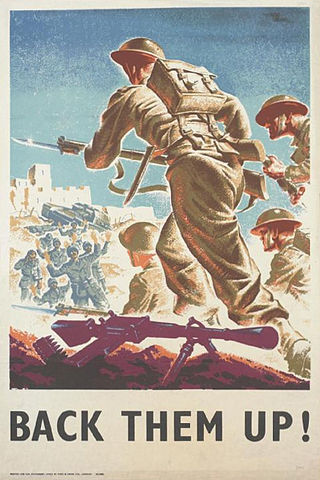
The military history of the United Kingdom in World War II covers the Second World War against the Axis powers, starting on 3 September 1939 with the declaration of war by the United Kingdom and France, followed by the UK's Dominions, Crown colonies and protectorates on Nazi Germany in response to the invasion of Poland by Germany. There was little, however, the Anglo-French alliance could do or did do to help Poland. The Phoney War culminated in April 1940 with the German invasion of Denmark and Norway. Winston Churchill became prime minister and head of a coalition government in May 1940. The defeat of other European countries followed – Belgium, the Netherlands, Luxembourg and France – alongside the British Expeditionary Force which led to the Dunkirk evacuation in June 1940.

Operation Bodyguard was the code name for a World War II deception strategy employed by the Allied states before the 1944 invasion of northwest Europe. Bodyguard set out an overall stratagem for misleading the Oberkommando der Wehrmacht as to the time and place of the invasion. Planning for Bodyguard was started in 1943 by the London Controlling Section, a department of the war cabinet. They produced a draft strategy, referred to as Plan Jael, which was presented to leaders at the Tehran Conference in late November and, despite skepticism due to the failure of earlier deception strategy, approved on 6 December 1943.

Operation Dragoon was the code name for the landing operation of the Allied invasion of Provence on 15 August 1944. Although initially designed to be executed in conjunction with Operation Overlord, the June 1944 Allied landing in Normandy, a lack of available resources led to a cancellation of the second landing. By July 1944 the landing was reconsidered, as the clogged-up ports in Normandy did not have the capacity to adequately supply the Allied forces. Concurrently, the high command of the French Liberation Army pushed for a revival of the operation that would include large numbers of French troops. As a result, the operation was finally approved in July to be executed in August.
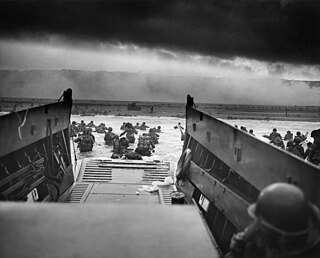
The Normandy landings were the landing operations and associated airborne operations on 6 June 1944 of the Allied invasion of Normandy in Operation Overlord during the Second World War. Codenamed Operation Neptune and often referred to as D-Day, it is the largest seaborne invasion in history. The operation began the liberation of France, and the rest of Western Europe, and laid the foundations of the Allied victory on the Western Front.

A beachhead is a temporary line created when a military unit reaches a landing beach by sea and begins to defend the area as other reinforcements arrive. Once a large enough unit is assembled, the invading force can begin advancing inland. The term is sometimes used interchangeably with bridgehead and lodgement. Beachheads were important in many military actions; examples include operations such as Operation Neptune during World War II, the Korean War, and the Vietnam War.
Operation Sledgehammer was an Allied plan for a cross-Channel invasion of Europe during World War II, as the first step in helping to reduce pressure on the Soviet Red Army by establishing a Second Front. It was to be executed in 1942 and acted as a contingency alternative to Operation Roundup, the original Allied plan for the invasion of Europe in 1943. Allied forces were to seize the French Atlantic ports of either Brest or Cherbourg and areas of the Cotentin Peninsula during the early autumn of 1942, and amass troops for a breakout in the spring of 1943.

Amphibious warfare is a type of offensive military operation that today uses naval ships to project ground and air power onto a hostile or potentially hostile shore at a designated landing beach. Through history the operations were conducted using ship's boats as the primary method of delivering troops to shore. Since the Gallipoli Campaign, specialised watercraft were increasingly designed for landing troops, material and vehicles, including by landing craft and for insertion of commandos, by fast patrol boats, zodiacs and from mini-submersibles. The term amphibious first emerged in the United Kingdom and the United States during the 1930s with introduction of vehicles such as Vickers-Carden-Loyd Light Amphibious Tank or the Landing Vehicle Tracked.

The United States Naval Special Warfare Command (USNSWC), also known as NAVSPECWARCOM and WARCOM, is the naval component of United States Special Operations Command, the unified command that oversees and conducts the nation's special operations and missions.

The Battle of Inchon, also spelled Battle of Incheon, was an amphibious invasion and a battle of the Korean War that resulted in a decisive victory and strategic reversal in favor of the United Nations Command (UN). The operation involved some 75,000 troops and 261 naval vessels and led to the recapture of the South Korean capital of Seoul two weeks later. The code name for the Inchon operation was Operation Chromite.

A breakout is a military operation to end a situation of investment by offensive operations that achieve a breakthrough—escape from offensive confinement. It is used in contexts such as this: "The British breakout attempt from Normandy". It is one of four possible outcomes of investment, the others being relief, surrender, or reduction.

Military gliders have been used by the militaries of various countries for carrying troops and heavy equipment to a combat zone, mainly during the Second World War. These engineless aircraft were towed into the air and most of the way to their target by military transport planes, e.g., C-47 Skytrain or Dakota, or bombers relegated to secondary activities, e.g., Short Stirling. Most military gliders do not soar, although there were attempts to build military sailplanes as well, such as the DFS 228.
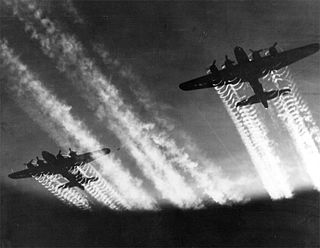
The military history of the United States during World War II covers the nation's role as one of the major Allies in their victory over the Axis Powers. The United States is generally considered to have entered the conflict with the 7 December 1941 surprise attack on Pearl Harbor by the Empire of Japan and exited it with the 2 September 1945 surrender of Japan. During the first two years of World War II, the US maintained formal neutrality, which was officially announced in the Quarantine Speech delivered by US President Franklin D. Roosevelt in 1937. While officially neutral, the US supplied Britain, the Soviet Union, and China with war materiel through the Lend-Lease Act signed into law on 11 March 1941, and deployed the US military to replace the British forces stationed in Iceland. Following the 4 September 1941 Greer incident involving a German submarine, Roosevelt publicly confirmed a "shoot on sight" order on 11 September, effectively declaring naval war on Germany and Italy in the Battle of the Atlantic. In the Pacific Theater, there was unofficial early US combat activity such as the Flying Tigers.

Operation Overlord was the codename for the Battle of Normandy, the Allied operation that launched the successful liberation of German-occupied Western Europe during World War II. The operation was launched on 6 June 1944 (D-Day) with the Normandy landings. A 1,200-plane airborne assault preceded an amphibious assault involving more than 5,000 vessels. Nearly 160,000 troops crossed the English Channel on 6 June, and more than two million Allied troops were in France by the end of August.

USS Samuel Chase (APA-26), launched as SS African Meteor, was an Arthur Middleton-class attack transport manned by the United States Coast Guard during World War II. She was named after Founding Father Samuel Chase, a signatory to the Declaration of Independence.
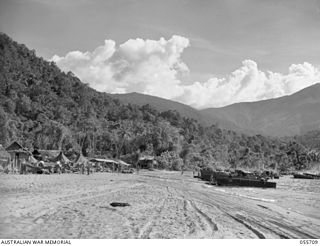
The Landing at Nassau Bay was an amphibious landing by Allied forces at Nassau Bay during the New Guinea campaign of World War II that took place between 30 June and 6 July 1943. The operation was undertaken so that Allies could secure a beachhead to establish a supply point to shorten their supply lines for the proposed attack on Salamaua as part of the Salamaua–Lae campaign and resulted in a battalion-sized force of US infantry and supporting elements being landed largely unopposed on the south-eastern flank of the battle zone.
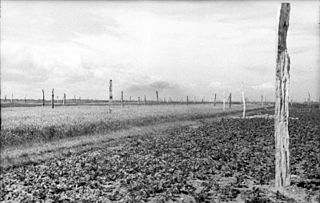
Rommel's asparagus were 4-to-5-metre logs which the Axis placed in the fields and meadows of Normandy to cause damage to the expected invasion of Allied military gliders and paratroopers. Also known in German as Holzpfähle, the wooden defenders were placed in early 1944 in coastal areas of France and the Netherlands against airlanding infantry. Rommelspargel took their name from Field Marshal Erwin Rommel, who ordered their design and usage; Rommel himself called the defensive concept Luftlandehindernis.

The Inter-Service Training and Development Centre (ISTDC) was a department under the British Chiefs of Staff set up prior to World War II for the purpose of developing methods and equipment to use in Combined Operations.

The Australian contribution to the Battle of Normandy involved more than 3,000 military personnel serving under British command. The majority of these personnel were members of the Royal Australian Air Force (RAAF), though smaller numbers of Australians serving with the Royal Navy and British Army also participated in the fighting prior to and after the Allied landings on 6 June 1944. While all the RAAF units based in the United Kingdom (UK) took part in the battle, Australians made up only a small portion of the Allied force.

The Alhucemas landing was a landing operation which took place on 8 September 1925 at Alhucemas by the Spanish Army and Navy and, in lesser numbers, an allied French naval and aerial contingent, that would put an end to the Rif War. It is considered the first amphibious landing in history involving the use of tanks and massive seaborne air support. Alhucemas is seen as a precursor of the Allied amphibious landings in World War II, and the first successful combined operation of the 20th century.


















